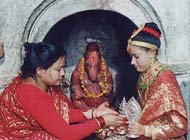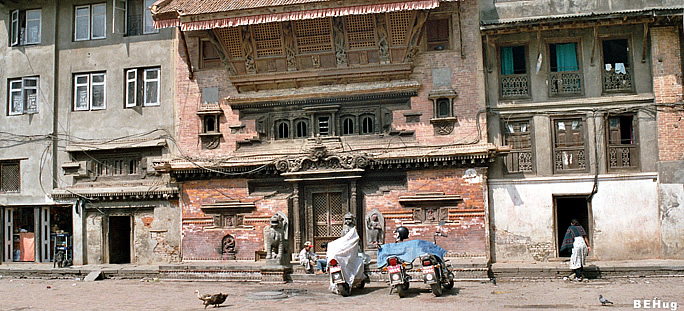| Kumari
- The living Goddess |
 |
Nepal Religion |
|
 |
Nepal Religion |
|
|
|

| Ex-Kumari
continues to enjoy her conjugal life, 84-years-old |
 |
 |
Ever
since the news of the enthronement of the new Kumari, Nepal's Living Goddess,
fell into the ear of 84-years-old Hira Maiya Shakya, she is impatient
to visit the Kumari House at Hanumandhoka Durbar Square, where the royal
goddess resides.
Happily
married to a craftsman of the Capital's Srighaa area 70 years ago, she
is the eldest among the surviving former Living Goddesses of the Himalayan
Kingdom. She is also a living proof of the fact that husbands of former
Kumaris do not land up in trouble as rumours circulating in the city have
it. |
|
Shakya
often thinks about "the ancient House with beautiful doors, windows and
wall paintings", where she spent "most precious years" of her life as the
Living Goddess or Kumari. That was in the 1920s. She becomes nostalgic
especially when she hears the news about the arrival or enthronement of
a new Kumari. "She is there to protect the country and the monarch," Shakya
proudly says echoing the popular belief.
She
was installed as the Kumari when she was just three years old. But she
was forced to retire in the same year after she contracted smallpox, an
epidemic then. And when she was just 15 years old, Hira's parents arranged
her marriage with the craftsman, Pratyaknanda Shakya.
"I
cannot quite remember whether I was happy or not when my mother told me
about the man. I think that was okay. I have been with him till now," she
says.
Her
life changed after she came to her husband's house, however. She had to
be obedient to her parents-in-law and work at the house day in and day
out. Hira Maiya rules out rumours that a former Kumari's husband lands
up in troubles or dies after marriage. "As I grew up, I heard about it,"
she says. "But those rumours did not affect our marital life at all. We
lived a happy conjugal life. He loves me so much even today."
Her
husband, Pratyaknanda, 87, says he feels proud to be a husband of a former
Kumari. He rules out the basis of the rumour, and says, "I do not
say Kumari's husbands never die; everyone has to die one day. There are
widows, widowers. It is natural and not because they were former Kumaris
or their husbands."
Hira
Maiya cannot properly remember those important days (when she was a Kumari),
but whenever she starts reminiscing those days she becomes excited. "It
was such anamazing experience, like a dream. I did not have to work like
my sisters. Everyone called me Goddess, and I could play as much as I liked,"
she adds.
She
also remembers whenever the king came in front of her and she put vermilion
tika on his forehead with her left hand. "The young King (Tribhuvan) came
and watched the preparations for the Kumari procession from the white barandah
of the Hanumandhoka Palace. Then he sat on the throne placed on the stone-paved
platform in front ofthe Kumari House," she says.
|



